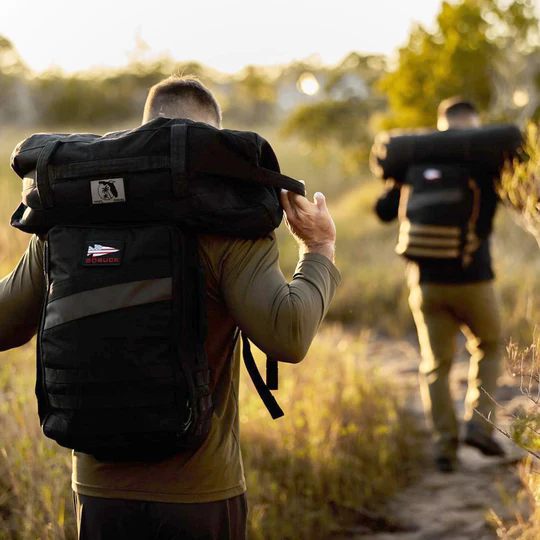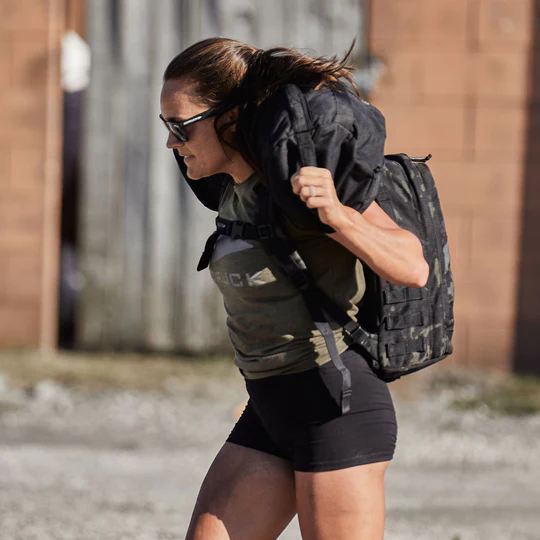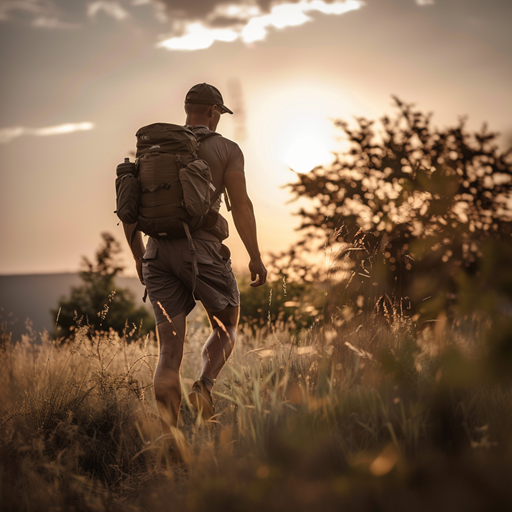Rucking is a term many may not be immediately familiar with, yet it’s an activity some have participated in without even realizing it (I know I didn’t!). At its core, rucking involves carrying a rucking backpack, a weighted backpack (commonly referred to as a rucksack) and walking for distance or time. This simple but effective form of cardio blends strength training with endurance that’s deeply rooted in military tradition where soldiers carry heavy packs over varied terrain. I find it an easily accessible form of exercise that doesn’t require expensive equipment; just a rucksack and some weight, and you’re ready to go.
While it might sound straightforward, the benefits of rucking run deep. Furthermore, It’s a scalable workout – meaning it can be adjusted for fitness levels from beginner to advanced. Adding weight challenges your muscles and cardiovascular system more than walking alone, but with less impact on the joints than running. I’ve learned the importance of proper form and gradual progression to prevent injury, and I’ve seen firsthand how it can improve posture, strength, and mental tenacity.
Key Takeaways
- Rucking integrates cardio with strength training using a weighted backpack commonly referred to as a rucking backpack.
- It’s a low-impact, adaptable workout suitable for a range of fitness levels.
- Proper technique and progression are essential for maximizing benefits and preventing injury.
Fundamentals of Rucking

In rucking, the essentials revolve around having the appropriate gear and a solid understanding of rucking basics. I’ll guide you through selecting the right equipment and cover the foundational concepts to ensure you get the most out of your rucking experience.
Choosing the Right Gear
The rucking backpack is central to the activity. When selecting one, look for sturdy construction and adjustable, padded shoulder straps for comfort. Equally, the weight of the backpack is also a crucial factor; beginners often start with a weighted backpack equating to 10% of their body weight. Distributing this weight evenly at the top of the backpack can improve balance and reduce strain.
- Ruck Plate: A flat weight designed for rucking (insert into backpack).
- Water Bladder: For hydration on the go.
- Comfortable Attire: Breathable clothing and supportive footwear.
Understanding Rucking Basics
What is rucking? Simply put, it’s walking with a weighted backpack. This exercise builds endurance, strength, and cardiovascular health. When beginning, maintain a brisk, consistent pace. For example, it’s advisable to start on flat terrain and gradually introduce varied landscapes to increase difficulty. Listening to my body for signs of strain and taking regular breaks has helped me prevent injury and fatigue during longer ruck marches.
Rucking Backpack Workouts
Rucking workouts are the cornerstone of rucking, a fitness activity that combines hiking with carrying a weighted backpack. Proper planning and technique can significantly enhance the effectiveness of your ruck workouts.
Planning Your Ruck Workout
Before I start my rucking workout, I ensure my plan is tailored to my fitness level and goals. Here’s what I generally follow:
| Week | Distance | Backpack Weight |
|---|---|---|
| 1 | 2 miles | 10 pounds |
| 2 | 3 miles | 15 pounds |
| 3 | 4 miles | 20 pounds |
| 4 | 5 miles | 25 pounds |
When planning, I take into account the total distance I’ll cover and the weight I’ll carry. For instance, I start with a manageable distance and weight, usually beginning with a 10-pound backpack for a couple of miles. Then, over time to increase the challenge, I add more weight and distance gradually to avoid injury and build endurance.
Rucking Backpack Techniques
My approach to rucking maximizes the workout’s benefits and minimizes the risk of injury. Key techniques include:
- Posture: I keep my back straight and engage my core, ensuring the weight is evenly distributed.
- Stride: I maintain a consistent, natural stride to avoid overexertion.
- Breathing: Steady, deep breaths help me maintain a rhythm and pace.
- Packing: I pack my backpack with the weight secured close to my body to maintain balance.
It’s essential to use a quality weighted backpack that fits well and offers good support. I always adjust the straps for a snug fit to keep the weight stable, which is crucial for longer distances.
Incorporating these techniques into my rucking workouts increases their effectiveness, building strength and endurance while minimizing the risk of discomfort and injury.
Health and Fitness Benefits

Rucking, which involves walking with a weighted backpack, offers distinct physical and mental health advantages that enhance my overall fitness and well-being. So let’s explore these rucking benefits in more detail.
Physical Benefits of using a Rucking Backpack
- Strength and Endurance: My muscles work harder during rucking due to the added weight, which strengthens my lower body, core, and shoulders. Compared to regular walking, I burn more calories, which contributes to fat loss and cardiovascular health. Studies show that rucking can burn up to 30% to 45% more calories than an unweighted walk.
- Posture and Balance: The weight of the backpack requires me to maintain good posture and balance, ultimately improving my body alignment and stability.
Mental Health Advantages
- Stress Reduction: The rhythmic nature of rucking helps me clear my mind, which lowers stress and anxiety levels.
- Cognitive Function: The outdoor environment combined with the physical challenge of rucking boosts my mood and can even enhance cognitive function. Carrying a load over varying terrain demands attention and mental agility, which keeps my mind engaged and sharp.
FAQ
What essential gear do you need to get started with rucking?
You’ll need a durable rucking backpack and comfortable footwear designed for walking or hiking. Select moisture-wicking socks to keep your feet dry.
How should you properly load a rucking backpack?
It’s crucial to distribute weight evenly in your backpack. Place heavier items close to your back and higher up to maintain balance and reduce strain.
Can you improve physical fitness through rucking, and if so, in what ways?
Yes, rucking enhances cardiovascular endurance, builds muscular strength, particularly in the lower body and core. Additionally, it can improve your posture, which is something I needed to fix.
What are the potential risks or disadvantages of rucking?
If not executed properly, rucking can lead to overuse injuries, back pain, and joint stress. Proper form and gradual progression are key to minimizing these risks.
How do you determine the appropriate weight for your rucking backpack?
Start with 5-10% of your body weight and gradually increase the weight. The maximum recommended load is 30% of your body weight for experienced individuals.
What are some effective rucking backpack workouts for beginners?
Beginners should start with short distances at a moderate pace with a light backpack. Over time, you can increase the weight and distance to enhance your rucking workout.

